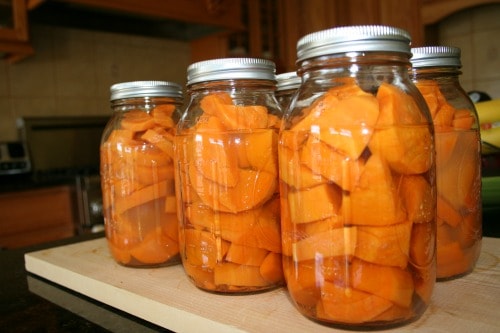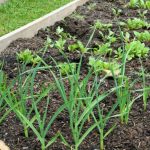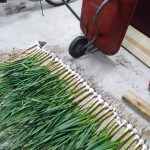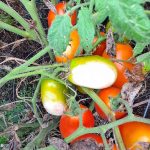If you grew sweet potatoes, it’s important to learn how to harvest sweet potatoes properly. The right time and method can help you keep them fresh during the winter.
This week, we’re celebrating fall by celebrating one of my favorite vegetables: sweet potatoes! Sweet potatoes are an excellent source of vitamin A, with each potato providing over 700% of your daily RDA for this important vitamin. They’re also a great source of vitamin C, providing 65% of your daily requirements for vitamin C, too. And they taste great!
Did you know that sweet potatoes have been cultivated for approximately 10,000 years? That’s not a typo. Remains of cultivated sweet potatoes have been found by archaeologists and tentatively dated to 8,000 B.C. South Americans grew sweet potatoes around this time, with evidence suggesting that Central Americans grew them as early as 5,000 B.C.
Sweet potatoes need long, hot summers to grow to maturity. There are newer varieties that can be grown in more northern climates. North Carolina is the sweet potato capital here in America, with Georgia and Virginia also producing an abundant crop.

Sweet Potatoes in My Home Garden
I can personally vouch for the abundant crop in Virginia. The first year that I grew sweet potatoes, I didn’t realize that the vines do tend to wilt after planting the slips, or starter plants. I panicked and planted double the amount I needed. The result was a whopping 63 pounds of sweet potatoes from about 20 plants.
This year is my fifth year growing sweet potatoes, and I did not panic. I planned my garden carefully. I purchased a package of 8 starter slips of “Beauregard,” a good variety for my zone 6b garden, and planted just 8 plants in early May. This weekend, I harvested the sweet potatoes, set them in the garage to cure, and canned 6 quarters for the winter. Canning sweet potatoes is also my blog topic for the Celebrate the Flavor of Fall blogger event.
How to Harvest Sweet Potatoes
Unlike other varieties of potatoes, sweet potatoes do not die back when they’re ready to be harvested. Instead, they give you very subtle clues that the delicious sweet potatoes are ready to be harvest
Signs That Sweet Potatoes Are Ready for Harvest
- Timing: When you purchase sweet potato slips or starter plants, the package information usually tells you how many days until harvest. That’s a rough estimate but it’s usually accurate. You can also look up the variety online to estimate the harvest date. I planted “Beauregard”, which matures in approximately 90 days. I planted the slips around Mother’s Day; June, July and August give me at least 90 days, with a few weeks on either side in May and September for a margin of error. It’s a good guess that they’ll be ready this week.
- Yellowing leaves: While leaves won’t die back entirely, you’ll start to notice yellow leaves here and there among the vines. This is a sign that there are mature tubers ready for harvest.
- Sweet potatoes actually poking out of the ground: In my garden, the raised beds provide a very lightweight soil. The sweet potato tubers actually begin poking out of the ground in late August. By mid to late September, I can feel with my fingers the size of the tubers. When they get this big, I know they’re ready to harvest.
How to Harvest Sweet Potatoes
Sweet potatoes can be easily bruised during harvesting, so be careful. Many gardening websites recommend using a spade, and if you’ve planted them in heavy soil, a spade is probably the way to go. I use a trowel and dig them up carefully. I begin digging where I planted the original slips.
Sweet potatoes can produce tubers within about a foot radius of the central plant, and I’ve found small slips starting where vines have rooted, so it’s a good idea to dig carefully out from where you find the first batch of potatoes. Dig them up gently and place them in the sunshine on the soil while you work. Discard the vines and pull them up as you work.
I use two wheelbarrows. I place the sweet potatoes in one wheelbarrow. In the second wheelbarrow, I pull up and discard the vines. I dump the vines at the edge of the woods, where nature will compost them down into the soil. You can either compost them or discard them.
When I’m finished, I pull the sweet potato filled wheelbarrow into a sunny location. Let them rest in the sunshine on a warm day to dry. Do not rinse off the dirt; just let them dry out.
Step 2 is curing your sweet potatoes so that you can store them through the winter. Tomorrow, I’ll share with you the steps to curing and storing sweet potatoes. Then we’ll talk about canning them.
Learn More About Growing and Storing Sweet Potatoes
You can learn more about how to grow and harvest sweet potatoes on Home Garden Joy. You may enjoy the following articles:








[…] already talked about knowing when to harvest sweet potatoes and how to harvest them. I mentioned in that blog post that you should not wash sweet potatoes, but […]